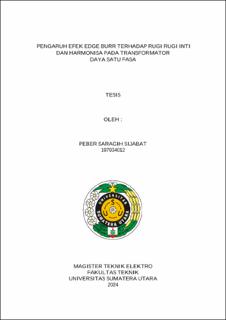| dc.contributor.advisor | Hasan, Syafruddin | |
| dc.contributor.advisor | Sinulingga, Emerson Pascawira | |
| dc.contributor.author | Sijabat, Peber Saragih | |
| dc.date.accessioned | 2024-08-28T08:53:40Z | |
| dc.date.available | 2024-08-28T08:53:40Z | |
| dc.date.issued | 2024 | |
| dc.identifier.uri | https://repositori.usu.ac.id/handle/123456789/96306 | |
| dc.description.abstract | A transformer is an electrical component whose function is to transfer and convert electrical energy from one or more circuits to another circuit through magnetic coupling and based on the principle of electromagnetic induction. Transformer performance is also limited by the magnetic flux of the iron core and saturation in the core. For cores made from ferromagnetic materials, it is highly recommended for making transformers. Edge burr is a cutting defect in the material that produces burrs on the edge of the core resulting from the cutting process by a cutting tool. Several factors that cause disturbances in transformers caused by edge burrs are increasing core losses which are influenced by increasing eddy currents and hesteresis, causing excessive heat which then results in Total Harmonic Distortion (THD). This research investigates the effect of edge burrs on transformer cores and their contribution to core losses and harmonics. The investigation was carried out experimentally on the edge of the core where there are burrs on the transformer, then the results were verified analytically using an equation approach based on theory, as well as with measurement results. Based on a burr depth of 1 mm with a magnetic flux gain of 0.9 to 1.8 Tesla, the core loss is 4.9365 Watts to 69.1005 Watts, while for an edge burr depth of 3 mm it is obtained from 5.9238 Watts to 78.64295 Watts. Compared to without edge burrs, 0.82275 Watts to 12.83295 Watts are obtained. so the egde burr affects the amount of power losses in the transformer. The effect of edge burr on harmonics with a depth of 1 and 3 mm when the dominant THD value increases at a flux density of 1.5 Tesla is 72.30 % and at a flux density of 1.8 Tesla it is 72.90 %. Likewise, the edge burr depth is 3 mm with THDt values of 72.50 % and 73.20 %. Meanwhile, the value of THDt starts to increase when the flux density is above 1.6 Tesla by 3.41%. The dominant harmonics are in the 1st, 3rd and 5th orders, while THDv is relatively close to constant at a value of 3.4 %. This research will provide a reference in transformer core design to improve the quality and reliability of the transformer. | en_US |
| dc.language.iso | id | en_US |
| dc.publisher | Universitas Sumatera Utara | en_US |
| dc.subject | Edge burr | en_US |
| dc.subject | core loss | en_US |
| dc.subject | harmonics | en_US |
| dc.subject | fluks | en_US |
| dc.subject | transformer | en_US |
| dc.subject | SDGs | en_US |
| dc.title | Pengaruh Efek Edge Burr terhadap Rugi Rugi Inti dan Harmonisa pada Transformator Daya Satu Fasa | en_US |
| dc.title.alternative | Influence of Edge Burr Effect on Core Losses and Harmonics in Single Phase Power Transformers | en_US |
| dc.type | Thesis | en_US |
| dc.identifier.nim | NIM197034012 | |
| dc.identifier.nidn | NIDN0001075904 | |
| dc.identifier.nidn | NIDN0030037707 | |
| dc.identifier.kodeprodi | KODEPRODI20101#Teknik Elektro | |
| dc.description.pages | 119 Pages | en_US |
| dc.description.type | Tesis Magister | en_US |


